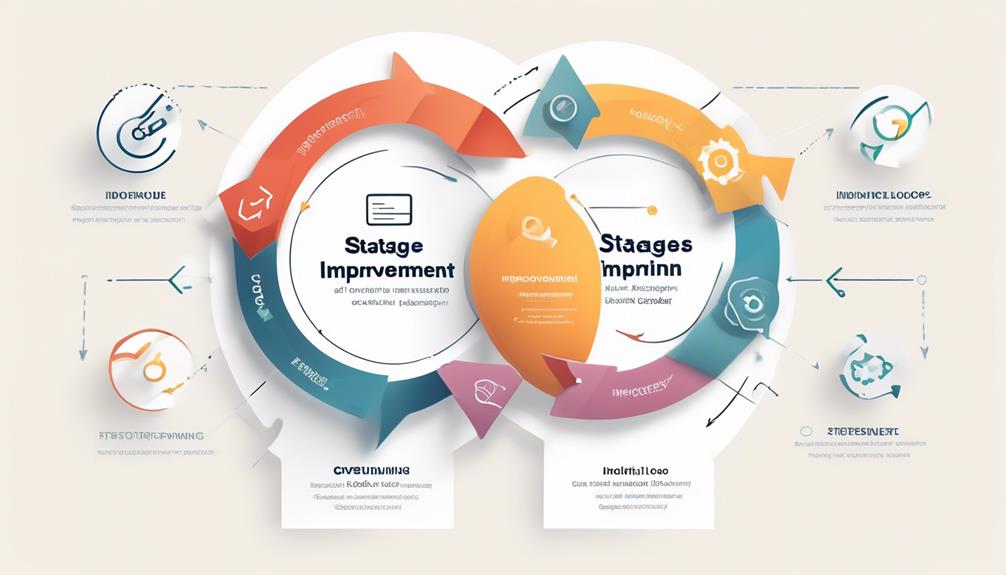In the rapidly evolving realm of quality assurance, efficiency is crucial for achieving success. Similar to a finely-tuned engine, implementing lean practices can enhance QA efficiency by streamlining processes and eliminating superfluous tasks, ultimately leading to improved productivity and superior quality results.
But what exactly are these lean practices, and how do they impact the QA process? Let’s explore the specific strategies and methodologies that contribute to driving QA efficiency with lean practices, and how they can revolutionize the way we approach quality assurance in today’s dynamic business landscape.
Key Takeaways
- Lean practices streamline processes and eliminate waste, leading to increased QA efficiency.
- Quality control measures integrated into every stage of the process ensure high-quality results.
- Continuous improvement is at the core of lean practices, driving ongoing refinement of processes.
- Efficient resource allocation and waste reduction strategies promote cost-effective QA practices.
Enhanced Operations Efficiency
Improving operations efficiency is crucial for optimizing productivity and reducing waste in any organization. By implementing lean practices, organizations can streamline their processes, enhance quality control, and achieve continuous improvement. This systematic approach focuses on waste reduction, process optimization, and ultimately, customer satisfaction.
Lean practices emphasize the elimination of non-value-added activities, allowing us to direct our efforts towards value-adding tasks. Through meticulous analysis of our operations, we can identify areas for improvement and implement changes that enhance efficiency. Quality control measures are integrated into every stage of the process, ensuring that the end product meets the highest standards.
Continuous improvement is at the core of lean practices. By constantly evaluating and refining our processes, we can adapt to evolving demands and stay ahead of the competition. This commitment to ongoing enhancement fosters a culture of excellence within the organization.
Waste reduction is a key focus of lean practices, as it directly contributes to improved efficiency. By minimizing unnecessary steps and optimizing resource utilization, we can achieve significant time and cost savings. This not only benefits the organization but also translates to enhanced customer satisfaction through timely delivery and high-quality products or services.
Waste Reduction

Lean practices, particularly in the realm of quality assurance, prioritize waste reduction as a means to streamline processes and optimize resource utilization. Implementing lean principles in quality control can significantly reduce waste and enhance overall efficiency.
Here are five key ways in which waste reduction drives QA efficiency with lean practices:
- Eliminating unnecessary processes: Lean principles help in identifying and eliminating non-value adding activities, reducing waste and improving overall efficiency.
- Optimizing resource allocation: Ensuring that resources are allocated efficiently reduces waste of time, effort, and materials, leading to cost savings and improved productivity.
- Promoting sustainability: Lean practices in quality assurance promote sustainable usage methods, contributing to environmental sustainability through waste reduction.
- Enhancing product delivery: By minimizing errors and defects, lean principles result in high-quality product delivery, optimizing resource allocation and reducing waste.
- Cost-effective practices: Reduction of waste in quality assurance leads to cost-effective practices, optimizing budget utilization and improving return on investment.
These strategies form the foundation for continuous improvement, driving QA efficiency and bolstering organizational success.
Eliminating Unnecessary Processes
Streamlining operations by eliminating unnecessary processes is a critical aspect of optimizing quality assurance and driving efficiency. The elimination of waste, a fundamental concept in lean practices, is essential for continuous improvement. Unnecessary steps not only impede progress but also consume valuable resources. To illustrate the impact of eliminating unnecessary processes, consider the following comparison table:
| Without Eliminating Unnecessary Processes | With Eliminating Unnecessary Processes |
|---|---|
| Redundant tasks waste time and effort | Streamlined operations save time and effort |
| Excessive documentation increases errors | Focused documentation reduces errors |
| Overly complex workflows hinder progress | Simplified workflows enhance productivity |
| Unused features clutter the system | Trimmed features improve usability |
| Inefficient resource allocation | Efficient resource utilization |
The elimination of waste not only reduces costs but also enhances quality by aligning business and quality assurance objectives. By adhering to LEAN principles in quality, unnecessary processes are identified and removed, resulting in cost-effective quality assurance and optimized budget utilization. This meticulous approach ensures that resources are utilized efficiently and effectively, leading to improved efficiency and quality.
Efficient Resource Use

We must optimize resource allocation to ensure maximum efficiency in our QA processes.
By implementing waste reduction strategies, we can minimize resource waste and maximize output.
Additionally, we need to focus on improving process efficiency to ensure that resources are used effectively and judiciously.
Resource Allocation Optimization
Efficient resource allocation is essential for maximizing productivity, reducing waste, and achieving cost savings and improved ROI. To optimize resource allocation, Lean Tools can be utilized to streamline processes and identify areas for improvement. This approach helps in reducing waste and enhancing efficiency and productivity.
Quality management principles play a vital role in ensuring that resources are allocated effectively to meet the organization’s objectives. Continuous improvement methodologies enable organizations to adapt and refine their resource allocation strategies over time.
By prioritizing tasks and projects based on resource availability, companies can ensure that the right resources are available at the right time, leading to improved productivity and reduced waste.
Additionally, efficient resource use promotes sustainability and environmental responsibility, aligning with broader organizational goals.
Waste Reduction Strategies
The key to optimizing resource allocation lies in the implementation of waste reduction strategies. These strategies not only streamline processes and enhance productivity but also align with broader organizational goals and principles of quality management.
Lean principles guide the identification and elimination of wasteful activities. They focus on continuous improvement and value stream mapping to enhance efficiency. By integrating quality control measures into the processes, organizations can reduce unnecessary steps, waiting time, and overproduction. This leads to better resource utilization and cost savings.
This approach not only enhances efficiency but also promotes sustainable usage methods, contributing to environmental sustainability. The systematic reduction of waste in processes ensures that time, effort, and materials are utilized effectively. This ultimately improves the overall quality of the deliverables while reducing operational costs.
Process Efficiency Improvement
To enhance process efficiency and resource utilization, organizations can implement lean principles to identify and eliminate wasteful activities, thereby optimizing operations and reducing costs.
This approach involves continuous improvement cycles to ensure ongoing enhancement of processes for efficient resource utilization.
Lean principles enable cost-effective quality assurance through efficient resource allocation, leading to the reduction of waste and the elimination of defects in business processes.
Continuous Improvement Cycle

We begin by examining the iterative nature of continuous improvement, focusing on the ongoing process enhancements that drive quality.
By implementing a cycle of identifying, defining, implementing, and measuring improvements, we ensure a methodical approach to refining our practices.
It’s crucial to continuously evaluate the effectiveness of the cycle, as it directly impacts the quality and efficiency of our operations.
Iterative Process Improvement
In our pursuit of QA efficiency, adopting iterative process improvement through a continuous improvement cycle has proven to be an invaluable strategy for refining and enhancing our operational processes over time.
This systematic approach allows us to continuously identify, define, implement, and measure processes for improvement, leading to the elimination of waste and the ongoing enhancement of operations.
Evaluation of the cycle ensures its effectiveness in making a quality impact, ultimately enhancing both quality control and efficiency.
This iterative process improvement not only contributes to reducing waste and cost savings but also plays a crucial role in ensuring customer satisfaction.
Ongoing Quality Enhancements
Embracing lean practices and integrating continuous improvement into our operations has led to ongoing quality enhancements through a systematic, iterative process aimed at refining and enhancing our operational processes over time. By continuously refining our processes, we aim to eliminate waste and improve overall operations, thereby positively impacting quality assurance and efficiency. The cycle involves identifying, defining, implementing, and measuring processes for improvement, ensuring that our focus remains on meeting and exceeding customer expectations. Evaluation of the cycle ensures its effectiveness in making a quality impact, leading to ongoing enhancement of quality and efficiency in our operations.
| Continuous Improvement Cycle | ||
|---|---|---|
| Identify | Define | Implement |
| Measure | Refine | Improve |
Implementing Continuous Improvement

To effectively implement continuous improvement, a systematic approach to identifying and addressing areas for refinement and optimization is essential. Continuous improvement is a cornerstone of lean practices, driving efficiency and quality control.
Here are five key aspects to consider when implementing continuous improvement:
- Establishing Metrics: Define clear metrics to measure the current state of processes and identify areas for improvement. This provides a baseline for assessing progress and the impact of changes.
- Employee Involvement: Encourage active participation from employees at all levels. Their insights and perspectives can uncover opportunities for improvement and foster a culture of continuous learning and development.
- Root Cause Analysis: Utilize structured problem-solving techniques, such as the 5 Whys, to get to the root cause of issues. This approach helps in addressing underlying problems rather than just symptoms.
- Iterative Refinement: Implement small, incremental changes rather than large-scale overhauls. This iterative approach allows for ongoing adjustments based on feedback and results.
- Knowledge Sharing: Foster a collaborative environment where best practices and lessons learned are shared across teams. This promotes a collective effort to improve overall processes and efficiency.
Impact on Quality

Lean principles drive efficiency in operations, resulting in a streamlined and effective quality assurance process. By eliminating waste in quality assurance processes, lean practices lead to minimal errors and defects, ultimately enhancing product quality while reducing costs.
Continuous improvement cycles, a hallmark of lean principles, ensure ongoing refinement of processes, further eliminating waste and enhancing overall operations. This commitment to continuous improvement not only boosts efficiency but also has a direct impact on product quality.
The implementation of lean principles leads to a significant increase in customer satisfaction, as it ensures consistent delivery of high-quality products and quicker delivery times.
Furthermore, the impact on quality is profound, as lean principles significantly improve efficiency and productivity through the elimination of waste in work processes, standardization, and process automation. This not only enhances the overall quality of the products but also leads to considerable cost savings.
Therefore, by integrating lean practices, organizations can achieve not only operational efficiency but also a marked improvement in the quality of their products and services.
Increased Customer Satisfaction

When considering the impact of lean practices on customer satisfaction, it’s essential to focus on process improvements, agile methodology, productivity, and quality.
These points directly contribute to the overall customer experience and satisfaction with the products or services provided. By leveraging lean principles to streamline processes and enhance product quality, we can meet customer needs more effectively, leading to increased satisfaction and loyalty.
Process Improvements
With a focus on customer feedback and satisfaction metrics, our process improvements have led to a significant boost in customer satisfaction through faster delivery of quality products. The lean principles we’ve embraced have enhanced our efficiency and effectiveness in the software testing process, ultimately leading to higher customer satisfaction.
Here are the key aspects of our process improvements:
- Continuous improvement through lean practices
- Enhanced quality control measures
- Waste elimination for cost-effective operations
- Quicker delivery of products
- Utilizing customer feedback for constant product improvements
These process improvements not only ensure consistent product quality and delivery but also contribute to waste reduction, ultimately enhancing overall customer satisfaction.
Agile Methodology
By embracing Agile methodology, our team has effectively increased customer satisfaction through streamlined development processes and rapid response to changing requirements. Agile practices have allowed us to continuously improve our processes, ensuring that we deliver high-quality products that meet or exceed customer expectations.
Through Agile, we’ve been able to reduce costs associated with rework and inefficiencies, ultimately leading to improved efficiency and leaner operations. This hasn’t only optimized our quality control measures but has also enhanced our ability to adapt to evolving customer needs.
The iterative nature of Agile development has enabled us to swiftly incorporate feedback, resulting in products that better align with customer requirements. Overall, Agile methodology has been pivotal in driving our commitment to customer satisfaction while maintaining a focus on lean and efficient practices.
Productivity and Quality
Increased customer satisfaction is directly linked to the implementation of lean principles, which significantly improve productivity and quality in our operations. The impact of lean practices on our efficiency and quality is profound:
- Lean principles boost efficiency in operations, leading to streamlined and effective quality assurance processes.
- Continuous improvement enhances quality and efficiency, resulting in increased customer satisfaction.
- Lean principles ensure high-quality product delivery through waste reduction and streamlined processes.
- Lean principles lead to cost-effective quality assurance, optimizing budget utilization and reducing unnecessary costs.
- Lean principles align business and quality assurance objectives, promoting collaboration for successful implementation.
Streamlined Work Processes

To achieve streamlined work processes, it is essential to implement lean principles that emphasize efficiency, standardization, and waste elimination. Lean practices drive continuous improvement and quality control, resulting in enhanced efficiency and waste reduction. Process automation plays a crucial role in standardizing tasks, reducing errors, and saving time for more critical activities. This standardization enables faster delivery of quality results, while the elimination of waste ensures efficient operations. Moreover, lean principles lead to enhanced teamwork and morale by promoting operational transparency, clear roles and responsibilities, and a problem-solving approach.
| Lean Practices Benefits | Description |
|---|---|
| Enhanced Efficiency | Lean principles dramatically improve efficiency and productivity through streamlined work processes. |
| Standardization | Process automation standardizes tasks, reduces errors, and saves time for more important tasks. |
| Waste Reduction | Elimination of waste in work processes enhances efficiency and ensures standardized processes, improving consistency and quality assurance. |
| Quality Results | Standardized processes enable faster delivery of quality results and the elimination of waste ensures efficient operations. |
| Team Morale | Lean principles lead to enhanced teamwork and morale through operational transparency, clear roles and responsibilities, and a problem-solving approach. |
Improved Teamwork and Morale

Improved teamwork and morale are essential elements that contribute to the overall efficiency and productivity of the quality assurance team. When team members work together cohesively and are motivated, the entire work environment becomes more conducive to continuous improvement and quality control.
Here are several key factors that can significantly impact teamwork and morale within a lean quality assurance environment:
- Operational Transparency: Sharing information and fostering an environment of openness enables team members to understand the bigger picture, align their efforts, and collaborate effectively.
- Clear Roles and Responsibilities: Establishing distinct roles and responsibilities creates a sense of ownership and accountability, leading to improved teamwork and efficiency.
- Problem-Solving Approach: Encouraging a problem-solving mindset empowers team members to actively engage in finding solutions, boosting morale and overall engagement.
- Streamlined Processes: Lean practices help streamline processes, reducing frustration and enhancing job satisfaction, which in turn positively impacts teamwork and morale.
- Culture of Continuous Improvement: Instilling a culture of continuous improvement fosters a sense of purpose and progress, driving teamwork and morale towards achieving higher levels of efficiency and quality.
High-Quality Product Delivery

Implementing lean practices facilitates the consistent and efficient delivery of high-quality products. By incorporating lean principles into our quality control processes, we ensure that our products meet and exceed customer expectations. Lean practices focus on reducing costs, eliminating waste, and optimizing efficiency, all of which directly contribute to the overall product quality. Through streamlined and standardized processes, we minimize errors and defects, resulting in a higher standard of product quality and consistency. Efficient resource allocation ensures that our products perform at their best, meeting the needs of our customers effectively. Additionally, the emphasis on continuous improvement means that we are constantly striving to enhance our product quality, leading to higher levels of customer satisfaction.
| Lean Principles | Benefits | Impact |
|---|---|---|
| Waste Reduction | Improved product quality and consistency | Minimizes errors and defects |
| Streamlined Processes | Efficient resource allocation | Enhances product performance |
| Continuous Improvement | Higher customer satisfaction | Drives ongoing enhancement of product quality |
Cost-Effective QA

By integrating lean principles into our quality assurance processes, we’ve effectively minimized unnecessary costs and optimized budget utilization, resulting in a cost-effective approach to quality assurance.
The implementation of lean practices has led to significant cost savings and enhanced efficiency in our quality control procedures. Through continuous improvement initiatives, we’ve been able to reduce costs while maintaining high standards of quality.
Our focus on value stream mapping has enabled us to identify and eliminate waste, leading to a more streamlined and cost-effective QA process. Additionally, our emphasis on efficient resource allocation has allowed us to maximize the use of available resources, resulting in improved ROI and reduced overall expenses.
- Adoption of lean principles for cost-effective QA
- Continuous improvement to reduce costs and enhance efficiency
- Emphasis on value stream mapping to eliminate waste
- Efficient resource allocation for optimized budget utilization
- Focus on high standards of quality control while minimizing unnecessary costs
These efforts haven’t only optimized our budget utilization but have also resulted in a more efficient and cost-effective quality assurance process.
Aligned Business and QA Objectives

Integrating lean principles into our business and quality assurance strategies facilitates the alignment of objectives, fostering a cohesive approach towards customer satisfaction and product quality. This alignment is essential for driving efficiency and continuous improvement in quality control processes. By eliminating waste and focusing on value-adding activities, lean practices help ensure that business and QA objectives are in sync, leading to more efficient processes and higher quality outcomes. Collaboration between business and QA teams is crucial for successfully implementing lean principles, as clear communication and shared goals contribute to the success of aligned business and QA objectives. The table below outlines the key components of aligned business and QA objectives.
| Aligned Business and QA Objectives | ||
|---|---|---|
| Lean Principles | Efficiency and Continuous Improvement | Eliminating Waste |
| Customer Satisfaction | Product Quality | Collaboration and Communication |
Frequently Asked Questions
What Is the Lean Process in Qa?
The lean process in QA centers on continuous improvement and waste reduction. It emphasizes efficiency, effectiveness, and customer satisfaction by identifying and eliminating non-value-added activities.
Lean practices optimize software testing, leading to faster delivery of high-quality products. By streamlining operations and processes, lean QA drives cost savings and consistent delivery of quality software.
Lean principles are applicable across various organizational settings, enhancing processes and customer satisfaction.
What Is the Lean Approach to Quality Improvement?
The lean approach to quality improvement focuses on eliminating waste, improving efficiency, and delivering value to customers. By streamlining processes and reducing unnecessary activities, we can enhance product quality and reduce defects.
This method emphasizes continuous improvement and empowers teams to identify and address issues promptly. Implementing lean practices in QA allows us to optimize resources and enhance productivity, ultimately driving greater efficiency and delivering higher quality products to our customers.
How Does Lean Operations Contribute to Quality?
Lean operations contribute to quality by optimizing processes and reducing waste, leading to streamlined and effective quality assurance. Continuous improvement ensures ongoing enhancement in operations, boosting customer satisfaction through waste reduction and quicker delivery of quality products.
What Is Lean Quality Management?
Lean quality management is a systematic approach to optimizing operations through waste reduction and process improvement. It emphasizes continuous improvement and problem-solving. An interesting statistic is that 67% of organizations report improved quality after implementing Lean practices.
This approach enhances efficiency, team collaboration, and problem detection. Lean principles facilitate faster delivery of quality results and declutter systems, leading to improved quality and cost optimization.
Conclusion
In conclusion, implementing lean practices in QA drives efficiency by streamlining processes and optimizing resources. It’s like trimming the fat from a piece of meat, leaving only the lean, high-quality parts.
This enhances operations, reduces waste, and aligns business and QA objectives, ultimately leading to faster delivery of top-notch results.
With continuous improvement and effective teamwork, lean practices ensure cost-effective, high-quality QA processes that meet customer satisfaction.
Randy serves as our Software Quality Assurance Expert, bringing to the table a rich tapestry of industry experiences gathered over 15 years with various renowned tech companies. His deep understanding of the intricate aspects and the evolving challenges in SQA is unparalleled. At EarnQA, Randy’s contributions extend well beyond developing courses; he is a mentor to students and a leader of webinars, sharing valuable insights and hands-on experiences that greatly enhance our educational programs.










